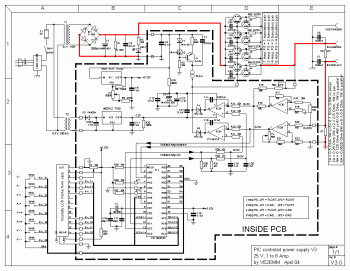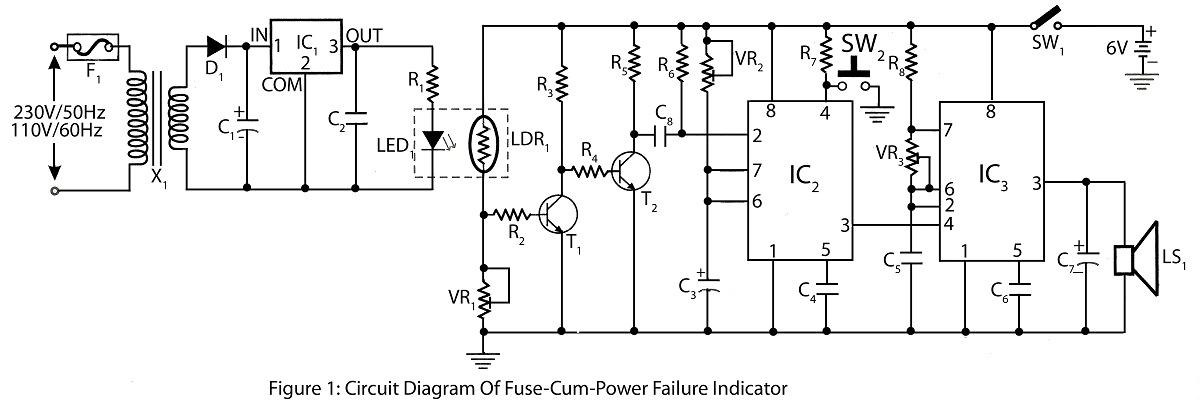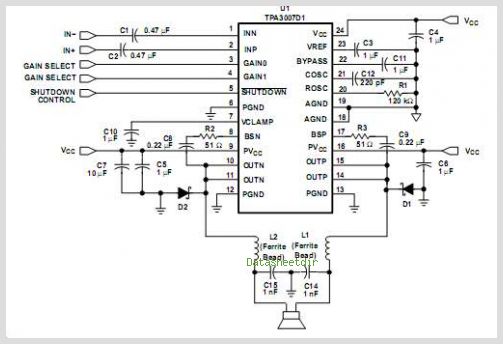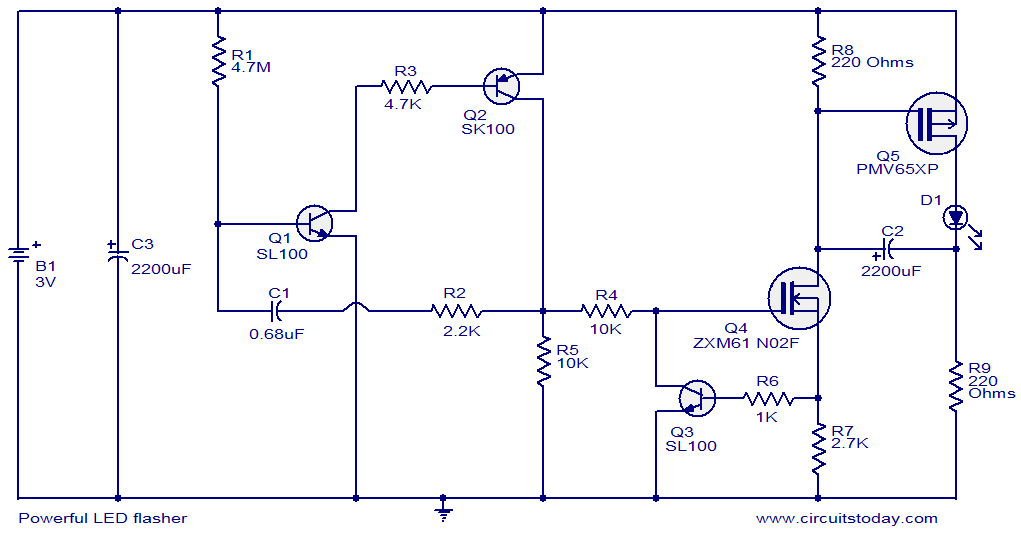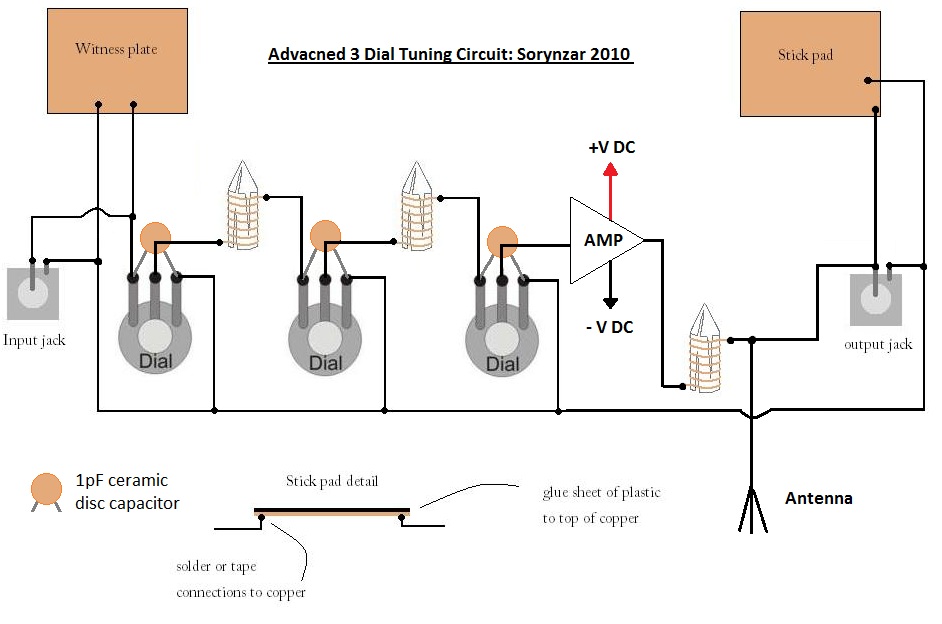
Complete SS Laser Power Supply Schematics
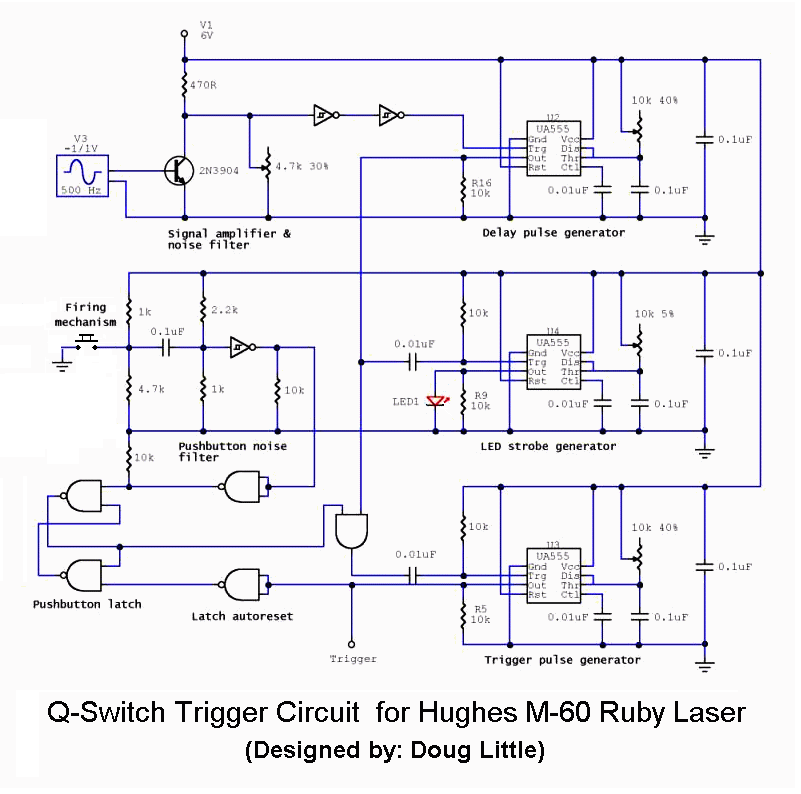
This chapter contains circuit diagrams for several power supplies designed for pulsed solid-state lasers. These include units suitable for driving the widely used Hughes ruby and YAG rangefinder laser assemblies, one utilizing the flash from a disposable pocket camera, and a high-energy flashlamp power supply for an 8-inch surplus NOVA laser rod. The pulse-forming network (PFN) is critical in determining the performance of a pulsed solid-state laser, allowing significant flexibility in the design of the capacitor charger and trigger circuits. Systems developed for other applications can often be adapted for solid-state laser power supplies. The chapter on SS Laser Power Supplies provides further information, and the schematics presented can be modified for various sizes and types of solid-state lasers. It is important to note that all these systems can be potentially lethal, with varying degrees of danger. Safety precautions must be strictly followed, and individuals should thoroughly read and understand the laser and electrical safety guidelines provided in this document before attempting to build or approach any of these systems. PFN1, with an unidentified manufacturer and model, comprises a 36 µF, 950 V energy storage capacitor, a 0.03 mH inductor, an automatic bleeder circuit, and various connectors. The capacitor is marked with its rating, while the inductor's value was determined through a ring test using a separate high-Q 1 µF capacitor. PFN1 was likely originally intended for use with the SSY1 laser head. The maximum useful energy delivered to the flashlamp is approximately 14 to 15 J when charged to just over 900 V. The assembly of Pulse Forming Network 1 is shown with major components labeled, and this unit was available from Meredith Instruments. When used as designed, the combination of the 36 µF capacitor and 0.03 mH inductor yields a pulse duration of 50 to 100 µs, with practical use closer to 100 µs. This duration is well-suited for a Nd:YAG rod, where 15 J should be sufficient to achieve the threshold for a 50 mm x 4 mm Nd:YAG rod, and it exceeds the requirements for a 25 mm rod. The capacitor in PFN1 is a high-quality non-electrolytic type, likely a polyester film capacitor, with an equivalent series resistance (ESR) around 0.02 Ohm. This low ESR is crucial for achieving the required short pulse duration with reasonable efficiency, maximizing energy transfer to the flashlamp. This power supply is appropriate for small military Nd:YAG lasers used in rangefinding, target designators, or illuminators. Typically, these lasers operate on batteries or onboard DC power lines, with pulse repetition rates around 10 pps. The power to charge the capacitor is usually supplied by a DC-to-AC converter, step-up transformer, high-voltage rectifier, PFN, and a parallel trigger circuit. Another commonly used military power supply operates on the principle of a flyback DC-AC converter. The calculations regarding the pulse width of the lamp align well with Nd:YAG's fluorescent lifetime of 230 µs, making this pulse width ideal for maximum energy transfer. PFN1-SCH, the schematic for Pulse Forming Network 1, includes the 36 µF energy storage capacitor, pulse shaping inductor, automatic bleeder circuit, and various connectors, wires, and a potentiometer. The automatic bleeder circuit is essential and should be preserved even if other components are modified or removed.
The design of the pulsed solid-state laser power supplies outlined in this chapter emphasizes the critical role of the pulse-forming network (PFN) in optimizing laser performance. The PFN's configuration enables the precise control of pulse duration and energy delivery, making it adaptable for various laser types and applications. The use of high-quality components, such as the non-electrolytic capacitor with low ESR, is vital for achieving efficient energy transfer to the flashlamp, ensuring that the laser reaches its operational threshold effectively.
In practical applications, the integration of the PFN with other power supply components, such as DC-to-AC converters and high-voltage rectifiers, is essential for maintaining the desired pulse characteristics. The automatic bleeder circuit plays a significant role in safety, preventing unintended discharges and ensuring that the system remains stable during operation. The specifications provided for the energy storage capacitor and inductor are critical for designers looking to replicate or modify these systems for specific requirements.
Overall, the information provided serves as a comprehensive guide for engineers and technicians involved in the design and implementation of pulsed solid-state laser systems, highlighting the importance of safety and precision in the development of high-energy laser applications.This chapter contains circuit diagrams for several power supplies for pulsed solid state lasers. These include units suitable for driving the popular Hughes ruby and YAG rangefinder laser assemblies as well, one using the flash from a disposable pocket camera, and a high energy flashlamp power supply for that 8 inch long surplus NOVA laser rod you have been saving. :) The pulse forming network is what determines the performance of a pulsed solid state laser. Thus, there is a great deal of flexibility in the design of the capacitor charger and trigger circuits. Systems designed for other applications can often be adapted for solid state laser power supplies. See the chapter: SS Laser Power Supplies for more information. And the schematics in this chapter can be easily modified for larger, smaller, or different types of solid state lasers.
WARNING: All of these systems are potentially lethal - some just more lethal than others. Hey, but when you`re dead, it probably doesn`t matter how well done you are. Before even thinking about building or going near one of these systems, make sure you have thoroughly read, understand, and follow the laser and electrical safety guideline provided elsewhere in this document! PFN1 (manufacturer and model unidentified) is a combination of a 36 uF, 950 V energy storage capacitor, .
03 mH inductor, automatic bleeder circuit, and various connectors and other stuff. The capacitor is marked with its rating but the inductor is not and its value was determined by performing a `ring test` using both a separate high-Q 1 uF capacitor and then the one in the PFN. The original application for PFN1 was most likely to be used with the SSY1 laser head (see the section: A Small Nd:YAG Laser - SSY1 ).
The maximum useful energy into the flashlamp is around 14 to 15 J when charged to just over 900 V. Pulse Forming Network 1 shows the assembly with major components labeled. This unit is/was available from Meredith Instruments. When used without modification, the combination of the 36 uF capacitor and 0. 03 mH inductor will result in a 50 to 100 us pulse duration (dependent on other circuit parameters, probably closer to 100 us in practice). This is quite well matched to a Nd:YAG rod. With a well designed cavity, 15 J should be enough to threshold a 50 mm x 4 mm Nd:YAG rod (which is what it apparently was intended to pump) and considerably more than enough for a 25 mm rod.
Note that the capacitor in PFN1 is a very high quality non-electrolytic type. It may be a Polyester film capacitor with an ESR (Equivalent Series Resistance) of around 0. 02 Ohm (compared to almost 1 Ohm for a combination of electrolytic photoflash caps with the same uF and V ratings). The extremely low ESR is essential to achieve the required short pulse duration at reasonable efficiency (i.
e. , maximizing energy transfer to the flashlamp) or at all. This power supply does sound right on the money for a small military Nd:YAG laser, as used in rangefinding, target designators, or illuminators. Typically these lasers are designed to run off of batteries or on-board DC power lines. Typical pulse repetition rates for these systems are on the order of 10 pps and power to charge the cap is usually provided by a DC-to-AC converter, step-up transformer, HV rectifier, PFN, and a parallel trigger circuit.
Another much used military PSU operates on the principle of a flyback DC-AC converter. Your calculations as to the pulse width of the lamp sound just about right. With Nd:YAG`s fluorescent lifetime being 230 us, this pulse width would make perfect sense for maximum energy transfer. PFN1-SCH - Pulse Forming Network 1. This includes the 36 uF energy storage capacitor, pulse shaping inductor, automatic bleeder circuit, and various (useless) connectors, wires, and a pot.
:) The automatic bleeder circuit is something that really should be kept intact even if the useless wiring and that pot are rem 🔗 External reference
The design of the pulsed solid-state laser power supplies outlined in this chapter emphasizes the critical role of the pulse-forming network (PFN) in optimizing laser performance. The PFN's configuration enables the precise control of pulse duration and energy delivery, making it adaptable for various laser types and applications. The use of high-quality components, such as the non-electrolytic capacitor with low ESR, is vital for achieving efficient energy transfer to the flashlamp, ensuring that the laser reaches its operational threshold effectively.
In practical applications, the integration of the PFN with other power supply components, such as DC-to-AC converters and high-voltage rectifiers, is essential for maintaining the desired pulse characteristics. The automatic bleeder circuit plays a significant role in safety, preventing unintended discharges and ensuring that the system remains stable during operation. The specifications provided for the energy storage capacitor and inductor are critical for designers looking to replicate or modify these systems for specific requirements.
Overall, the information provided serves as a comprehensive guide for engineers and technicians involved in the design and implementation of pulsed solid-state laser systems, highlighting the importance of safety and precision in the development of high-energy laser applications.This chapter contains circuit diagrams for several power supplies for pulsed solid state lasers. These include units suitable for driving the popular Hughes ruby and YAG rangefinder laser assemblies as well, one using the flash from a disposable pocket camera, and a high energy flashlamp power supply for that 8 inch long surplus NOVA laser rod you have been saving. :) The pulse forming network is what determines the performance of a pulsed solid state laser. Thus, there is a great deal of flexibility in the design of the capacitor charger and trigger circuits. Systems designed for other applications can often be adapted for solid state laser power supplies. See the chapter: SS Laser Power Supplies for more information. And the schematics in this chapter can be easily modified for larger, smaller, or different types of solid state lasers.
WARNING: All of these systems are potentially lethal - some just more lethal than others. Hey, but when you`re dead, it probably doesn`t matter how well done you are. Before even thinking about building or going near one of these systems, make sure you have thoroughly read, understand, and follow the laser and electrical safety guideline provided elsewhere in this document! PFN1 (manufacturer and model unidentified) is a combination of a 36 uF, 950 V energy storage capacitor, .
03 mH inductor, automatic bleeder circuit, and various connectors and other stuff. The capacitor is marked with its rating but the inductor is not and its value was determined by performing a `ring test` using both a separate high-Q 1 uF capacitor and then the one in the PFN. The original application for PFN1 was most likely to be used with the SSY1 laser head (see the section: A Small Nd:YAG Laser - SSY1 ).
The maximum useful energy into the flashlamp is around 14 to 15 J when charged to just over 900 V. Pulse Forming Network 1 shows the assembly with major components labeled. This unit is/was available from Meredith Instruments. When used without modification, the combination of the 36 uF capacitor and 0. 03 mH inductor will result in a 50 to 100 us pulse duration (dependent on other circuit parameters, probably closer to 100 us in practice). This is quite well matched to a Nd:YAG rod. With a well designed cavity, 15 J should be enough to threshold a 50 mm x 4 mm Nd:YAG rod (which is what it apparently was intended to pump) and considerably more than enough for a 25 mm rod.
Note that the capacitor in PFN1 is a very high quality non-electrolytic type. It may be a Polyester film capacitor with an ESR (Equivalent Series Resistance) of around 0. 02 Ohm (compared to almost 1 Ohm for a combination of electrolytic photoflash caps with the same uF and V ratings). The extremely low ESR is essential to achieve the required short pulse duration at reasonable efficiency (i.
e. , maximizing energy transfer to the flashlamp) or at all. This power supply does sound right on the money for a small military Nd:YAG laser, as used in rangefinding, target designators, or illuminators. Typically these lasers are designed to run off of batteries or on-board DC power lines. Typical pulse repetition rates for these systems are on the order of 10 pps and power to charge the cap is usually provided by a DC-to-AC converter, step-up transformer, HV rectifier, PFN, and a parallel trigger circuit.
Another much used military PSU operates on the principle of a flyback DC-AC converter. Your calculations as to the pulse width of the lamp sound just about right. With Nd:YAG`s fluorescent lifetime being 230 us, this pulse width would make perfect sense for maximum energy transfer. PFN1-SCH - Pulse Forming Network 1. This includes the 36 uF energy storage capacitor, pulse shaping inductor, automatic bleeder circuit, and various (useless) connectors, wires, and a pot.
:) The automatic bleeder circuit is something that really should be kept intact even if the useless wiring and that pot are rem 🔗 External reference
Warning: include(partials/cookie-banner.php): Failed to open stream: Permission denied in /var/www/html/nextgr/view-circuit.php on line 713
Warning: include(): Failed opening 'partials/cookie-banner.php' for inclusion (include_path='.:/usr/share/php') in /var/www/html/nextgr/view-circuit.php on line 713
